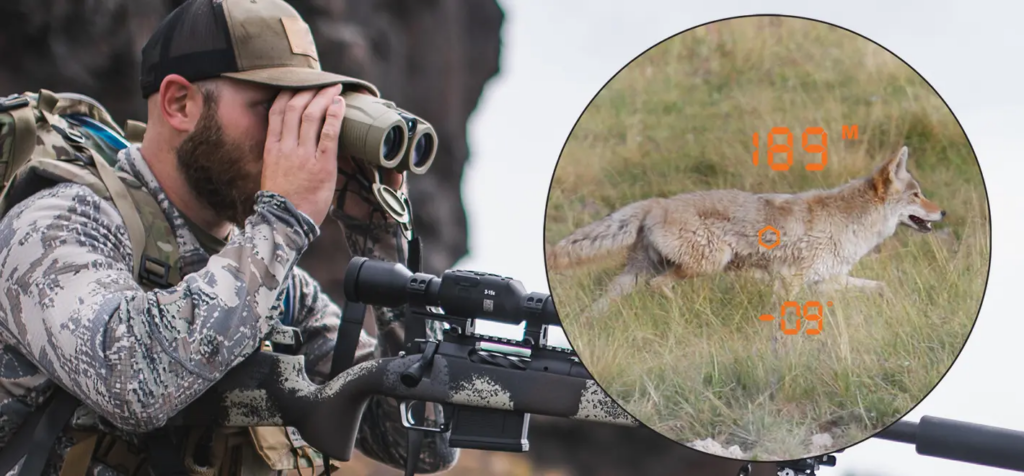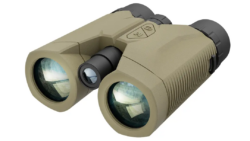Introducing the ATN 10x42 LRF Laser Ranging Binoculars

Primarily known for their night vision devices, ATN Corp. has recently introduced these “daytime” binoculars with laser rangefinding capabilities into their line-up.
Available in two variants depending on the maximum range of the onboard laser rangefinder (2000y/m BN1042LRF2K or the 3000y/m BN1042LRF2K) the new ATN 10x42 LRF 2000 binoculars and ATN 10x42 LRF 3000 binoculars are an interesting addition to the growing list of 10x42 binoculars with laser ranging capabilities.
I hope to get my hands on a set of these ATN 10X42 LRF binoculars to test and review fully in the future, but until then, let’s delve into their advertised features and capabilities and see what we can ascertain from that:
10x42 Configuration
Before we take a look at the rangefinding capabilities, let’s first consider their optical qualities
Designed with hunting in mind (rangefinder binoculars are also useful in a number of other areas), the classic, tried-and-trusted combination of a 10x magnification with 42mm objective lenses instantly puts these in the general use category meaning that whilst they may not be the ideal choice in extreme situations (so for example extremely low light conditions or extremely long ranges), they should be able to more than handle their own in almost all areas and conditions.

Optical Quality
In terms of details as to exactly what glass and coatings are used on these ATN 10X42 LRF binoculars, ATN Corp, is a little shy in terms of specifics, which always makes me a little suspicious. This is because in general if a brand uses very high-end glass and coatings, they tend to shout about it and make it a feature of their marketing strategy.
Anyway, let us look at what we do know and what I have been able to unearth:
Optical Coatings
In their specification sheet, the ATN 10x42 LRF binoculars are listed as having an optical system with “Multi-layer coatings“.

The exact wording here is important: To me this means that whilst the glass surfaces that have been treated have multiple layers of an anti-reflection treatment added to them (which is good), they fail to include the “Fully Mulit-Layer coatings” tag, which implies that not all glass surfaces through the whole system have been treated.
Usually, this means only the first and last glass surface are treated which costs less than treating every single surface throughout the whole optical pathway. The down-side is they will potentially not be as bright or sharp as equivalent fully multi-coated 10x42 binoculars due to undesired reflections as the light passes through them on its way to your eyes. For more on this, take a look at the optics section in my guide on What To Look For When Buying Binoculars.
Optical Glass
Lenses
Other than to say the objectives have a diameter of 42mm, ATN makes no mention as to the quality of glass used or the specific make-up of the elements that make up any of their lenses. So I cannot comment.
Prisms
ATN also makes no mention of it, but from the shape of the instrument (Roof vs Porro Prism), we can be pretty certain that they use roof prisms and not porro prisms to correct the inverted image:


Roof prisms are great because they allow for a more compact binocular, but to get the best out of them, they do need to be made of high-quality glass and have a couple of special coatings added to them in order to achieve an image that is as bright and sharp as an equivalent porro prism instrument.
Unfortunately, here again ATN makes no mention of the glass or any of the coatings used on their prisms in their marketing and spec sheet. I also searched for any information and came up empty-handed, so I can’t really comment other than to say once again, the lack of information is usually not a good thing. In my experience when a binocular manufacturer uses something of high quality, they shout about it.
Optical Specifications
- Magnification: 10x
- Objective Lens Diameter: 42 mm
- Binoculars Focus System: Fixed Focus / Focus Free
- Eye Relief: 16mm
- Min Focus Distance: 10m / y (32ft)
- The angle of View: 7 degrees
- Diopter Adjustment Range: ±5
- Optical Coatings: Multi-Layer Coatings
Fixed Focus System
An interesting aspect of these ATN binoculars is that they use a fixed focus (sometimes called focus-free) system, which is another nod to them being designed with the hunter in mind as it means once they have been set to your particular vision, no further focusing adjustments are required (from the minimum focus distance to infinity), which makes for quicker target locating and make the binocular easier to use one-handed, which if you are also carrying other gear like a weapon is important.
The main downside to this system is that they are less useful at close range (which can be seen with their long minimum focus distance of 10m / 32ft).
Eye-Relief
At 16mm the level of eye-relief is what I would describe as good, but not excellent. This means that you may be able to use them with glasses or some sort of eye protection and get the full field of view, but it is not certain. For more: Long Eye Relief Binoculars and How To Use Binoculars With Glasses.

Laser Rangefinder Specifications
- LRF Range: 5-2000m (BN1042LRF2K) or 5-3000m (BN1042LRF3K)
- LRF wavelength: 905nm
- Accuracy: ±1 meter (y)
- Heads-Up Display: High Transmission, OLED
- Bluetooth: Yes
- Battery: 1x CR2 (3v)
- Compatibility: Android & Apple Apps, ATN Mars 4, Mars 5, ThOR 4, ThOR 5, X-Sight 4K Pro, X-Sight 5 rifle scope series.
LRF Ranges
I like that you can choose between the two different models, either the ATN 3000 10x42 or the ATN 2000 10x42 binocular depending on your typical rangefinding needs.
If you take a look at some of the Best 10x42 Laser rangefinder binoculars on the market, you typically get a range of about 1200m (yards) to around 2000m (yards), so both options comfortably meet or exceed this.
- Leica Geovid HD-R 10x42 Laser Rangefinder Binoculars: 10 to 2200 yards
- Bushnell 10x42 Fusion Laser Rangefinder Binoculars: 10 to 1760 yards (to 500 yards for deer)
- Vortex Fury HD Laser Rangefinder Binoculars: 10 to 1600 yards (to 1000 yards for deer)
- Swarovski EL Range 10x42 Rangefinder Binoculars: 33 to 1500 yards
So as you can see, with either option of ATN 10x42 LRF binocular, the laser (in terms of maximum range) looks to be excellent.

Heads-Up Display

The ATN LRF binoculars feature an “enhanced” OLED display which can show the measurements taken by the LRF in either meters or yards.
The OLED screen also has a battery level indicator, showing a battery icon that indicates when the battery level is low.
Bluetooth Connectivity:
ATN 10x42 LaserBallistics (ATN 10x42 LRF 2000 binoculars and ATN 10x42 LRF 3000 binoculars) can pair with your ATN Smart HD Scope as well as many other rifle scopes via Bluetooth.
Or you can connect to the ATN Ballistic Calculator App available in the Google Play Store or Apple Store.
Included Accessories
With a soft carry case, neck strap and lens cloth, these ATN rangefinding binoculars come supplied with the usual assortment of accessories and nothing more. As primarily a binocular for hunting and wildlife observation, it would be nice if they had included a bino harness… we can always wish!
Conclusion
In summary, as a rangefinder, both the ATN LRF 2000 and ATN LRF 3000 10x42mm Ballistics Laser Rangefinding Binoculars look to be more than competent in terms of range and connectivity features.
In regards to the level of optics used and the resultant image quality, I need more information and ideally a hands-on test before I come to any sort of definite conclusions (watch this space).
Cost & Where to Buy

At the time of writing:
- ATN LRF 2000 10x42 Ballistics Laser Rangefinding Binocular BN1042LRF2K has a list price of $549, but retails for $479
- ATN LRF 3000 10x42 Ballistics Laser Rangefinding Binocular BN1042LRF3K has a list price of $599, but retails for $589

 May 9, 2024 | Posted by Best Binocular Reviews
May 9, 2024 | Posted by Best Binocular Reviews 
 Categories:
Categories:  Tags:
Tags: 
